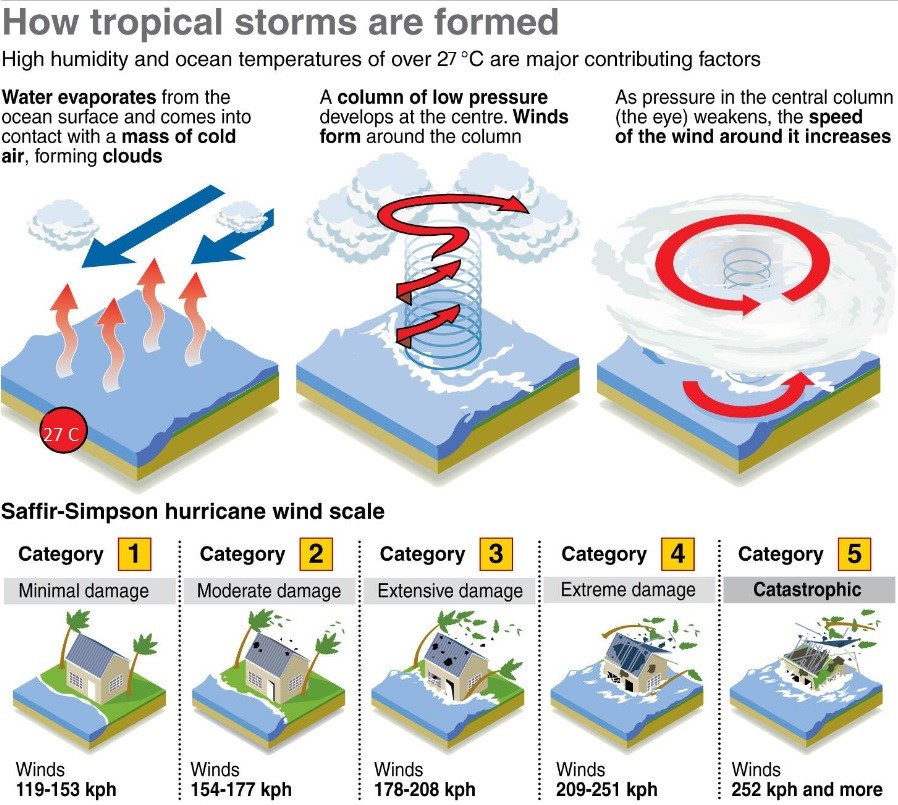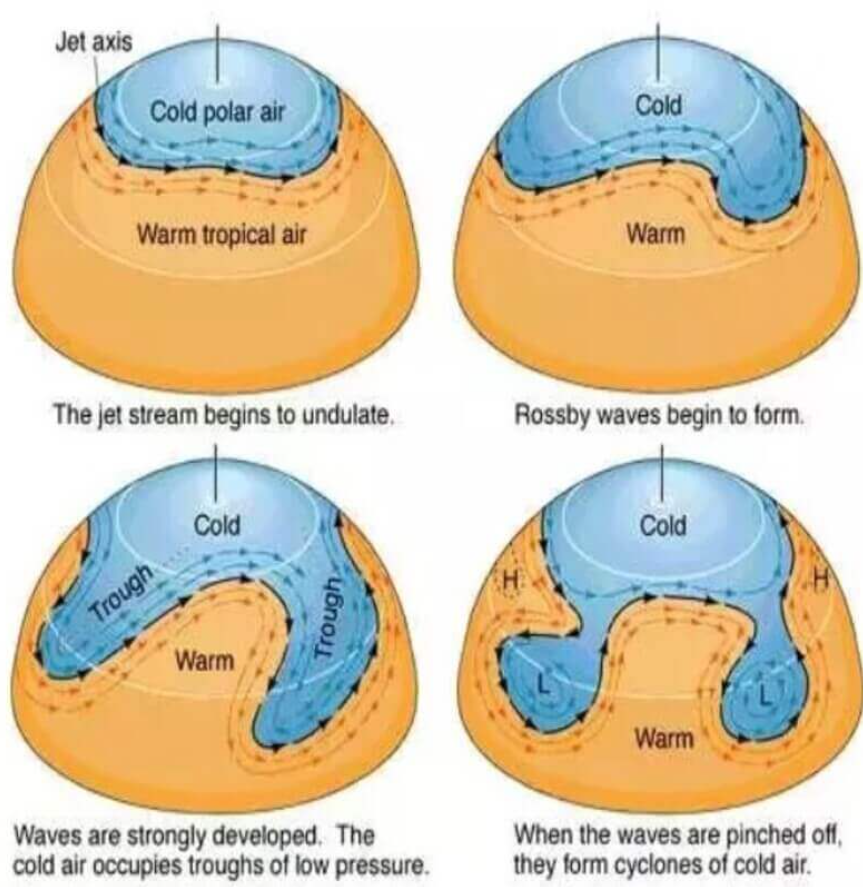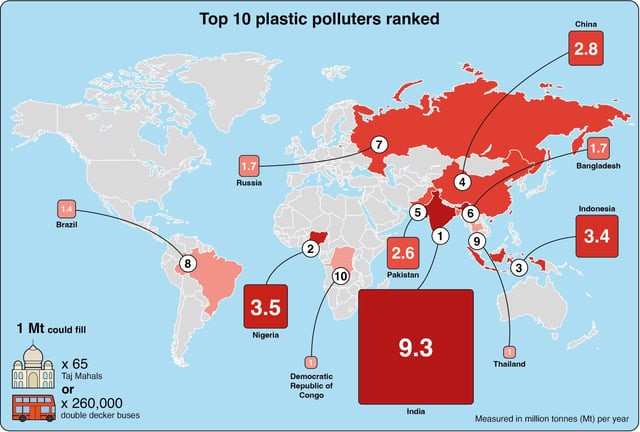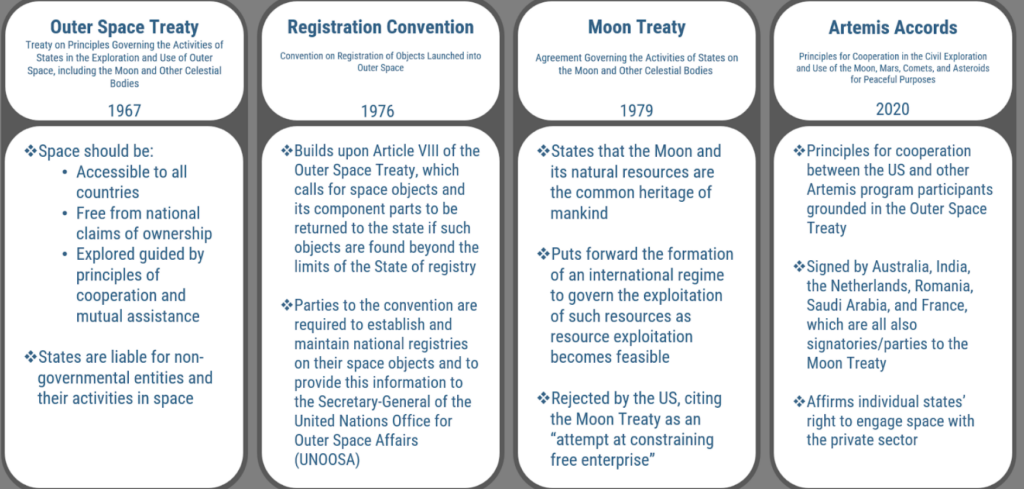9 September 2024 : Daily Current Affairs
1. On uncommon cyclones in the Arabian Sea
- 1. On uncommon cyclones in the Arabian Sea
- 2. How changes in the level of Arctic sea ice can change monsoon patterns in India
- 3. India Contributes 20% to Global Plastic Pollution, Study Reveals
- 4. Global Push to Regulate AI in Warfare Grows, India Urged to Engage in Shaping Norms
- Prelims Facts
- 1. Ukraine hopes that India will ‘review’ its decision on joining the Swiss peace process, says Ambassador
- 2. India’s military diplomacy in top gear with back-to-back exercises
- 3. Planetary protection: keeping out ‘toxic aliens’
- 4. Land of Former Pakistan President Pervez Musharraf Listed for Sale Under Enemy Property Act
- 5. Entod Pharmaceuticals Launches India’s First Eye Drop to Reduce Dependency on Reading Glasses for Presbyopia
- 6. Suspected Mpox case under investigation; patient put under isolation, no cause for alarm
(Source – The Hindu, International Edition – Page No. – 10)
| Context |
|

Introduction to the Indian Ocean’s Cyclones
- The Indian Ocean is notable for its monsoonal circulation and dramatic seasonal wind reversals north of the equator.
- It is unique due to ‘oceanic tunnels’ connecting it to the Pacific Ocean and the Southern Ocean:
- Pacific Tunnel: Transports warm water in the upper 500 metres.
- Southern Ocean Tunnel: Brings cooler waters below approximately 1 kilometre.
Cyclogenesis and the Monsoon Impact
- Monsoonal Circulation: Influences cyclogenesis by affecting heat content and atmospheric convection, leading to cyclones primarily during the pre-monsoon and post-monsoon seasons.
- Seasonal Patterns:
- Pre-Monsoon: Arabian Sea warms rapidly while the Bay of Bengal becomes warmer, producing atmospheric convection and rainfall.
- Post-Monsoon: The northeast monsoon brings significant rain to several states.
Reasons for Traditional Less Frequency of Cyclones in Indian Ocean
- Cooler Waters: The Arabian Sea and Bay of Bengal generally have cooler temperatures compared to other cyclone-prone regions.
- Wind Shear: Strong vertical wind shear in the Indian Ocean disrupts cyclone formation by stripping away energy from developing systems.
- Less Convective Activity: The Arabian Sea has relatively lower convective activity, reducing cyclonic formation.
- Monsoonal Influence: During the monsoon, intense wind patterns and evaporation affect cyclone development, particularly in the Arabian Sea.
Reasons for Increasing Frequency of Cyclones
- Warming Oceans: Rising sea surface temperatures due to global warming enhance cyclogenesis by increasing heat content available for cyclones.
- Climate Change Impacts: Increased heat from the Pacific and Southern Oceans boosts temperatures in the Indian Ocean, contributing to more frequent cyclones.
- Atmospheric Changes: Changes in wind patterns, humidity, and the weakening of monsoonal winds alter cyclone dynamics.
- Extended Cyclone Seasons: Modified climate conditions extend the duration of favourable cyclone formation periods.
- Enhanced Moisture Supply: Greater evaporation rates due to warmer waters increase moisture availability, fueling cyclone formation.
Cyclone Asna: A Case Study
- Occurrence: Cyclone Asna formed in August 2023, marking the first August cyclone in the north Indian Ocean since 1981.
- Formation: Originated from a strong land-born depression that transitioned to the warm Arabian Sea.
- Characteristics: Unusual for its powerful growth over land, using soil moisture and energy from the Arabian Sea.
- Impact: Caused nearly 50 deaths and significant damage to crops and property before dissipating due to dry desert air.
- Climate Context: The cyclone’s development was influenced by global warming, El Niño, and possibly underwater volcanic activity.
Conclusion
- The evolution of Cyclone Asna exemplifies the unpredictable nature of cyclonic activity influenced by climatic changes and unusual oceanic conditions.
- The 2023-2024 climate anomalies have led to a series of extreme weather events, reflecting the complex interplay between warming oceans and global climate patterns.
| PYQ: Discuss the meaning of colour-coded weather warnings for cyclone prone areas given by India Meteorological Department. (150 words/10m) (UPSC CSE (M) GS-1 2022) |
| Practice Question: Analyse the factors contributing to the recent increase in cyclone activity in the Arabian Sea. Discuss the impact of climate change and regional oceanic conditions on this trend. What are the potential implications for coastal regions in India. (250 Words /15 marks) |
2. How changes in the level of Arctic sea ice can change monsoon patterns in India
(Source – The Hindu, International Edition – Page No. – 11)6
| Context |
|
Impact of Arctic Sea Ice on the Indian Monsoon:
Introduction to the Indian Monsoon
- In recent years, erratic and unpredictable rainfall has plagued the Indian monsoon, causing droughts and floods.
- Climate change is a significant driver, but a complex interaction of multiple climatic factors also contributes to these changes.
- A new study, published in Remote Sensing of Environment by Juhi Yadav et al., from the National Centre for Polar and Ocean Research (NCPOR), and South Korea’s Korea Polar Research Institute, reveals that seasonal variations in Arctic sea ice also impact the Indian summer monsoon rainfall (ISMR).
- Various studies suggest that the declining Arctic sea ice due to climate change affects the ISMR.
Mechanics of the Indian Summer Monsoon
- The ISMR, active from July to September, is one of the world’s most notable monsoon systems, responsible for bringing significant rainfall to the Indian subcontinent.
- As the summer months approach, the Central Asian and Indian landmass heats up more rapidly than the surrounding oceans.
- This creates a low-pressure zone, which pulls in moisture-laden winds from the ocean.
- The southwest monsoon, after crossing the equator, splits into two arms: one brings rain to India’s western coast via the Arabian Sea, while the other impacts the eastern and northeastern regions from the Bay of Bengal.
- The ISMR system is more complex than initially thought, influenced by ocean surface temperatures, pressure gradients, atmospheric waves, and the circum-global teleconnection (CGT), a wave pattern in the mid-latitudes.
Findings of the Study
- Central Arctic Sea Ice Impact:
- Reduced sea ice in the central Arctic leads to less rainfall over western and peninsular India but increases rainfall in central and northern regions.
- Barents-Kara Sea Region Impact:
- Low sea ice in the Barents-Kara Sea region delays the monsoon’s onset and makes it more unpredictable, impacting rainfall patterns.
Atmospheric Systems Influencing Monsoon Patterns

- Rossby Waves and Their Effect:
- When sea ice in the central Arctic increases, heat transfers from the ocean to the atmosphere, triggering cyclonic circulation in lower latitudes.
- This strengthens Rossby waves, which influence weather patterns globally. The Rossby waves enhance high pressure over northwest India and low pressure over the Mediterranean, affecting the subtropical easterly jet over India.
- This results in an anomalous high-pressure system over Central Asia, causing more rain over western and peninsular India.
| Rossby Waves: |
|
- Barents-Kara Sea Ice Decline:
- Low sea ice in the Barents-Kara region triggers high pressure over southwest China and leads to a positive Arctic Oscillation.
- The reduced sea ice also leads to anticyclonic circulation over northwest Europe, disturbing atmospheric stability in subtropical Asia and India.
- This results in high rainfall over northeastern India but drier conditions in central and northwest India.
The Role of Climate Change
- Climate change has intensified the reduction of Arctic sea ice, exacerbating the variability and unpredictability of the ISMR.
- As sea ice levels continue to drop, more frequent and severe droughts, alongside excessive rainfall and flooding, are likely in different regions of India.
- The study underscores the importance of Arctic sea ice in influencing global climate systems, with direct effects on the Indian monsoon.
Conclusion
- The findings highlight the intricate relationship between Arctic sea ice and the Indian monsoon, showcasing how far-reaching the effects of sea ice loss can be.
- The study emphasises the need for more extensive research into these climate dynamics and the necessity for accurate forecasts to anticipate monsoon variability in the future.
|
PYQ: Q.1 How far do you agree that the behaviour of the Indian monsoon has been changing due to humanising landscapes? Discuss. (200 words/12.5m) (UPSC CSE (M) GS-1 2015) Q.2 What characteristics can be assigned to a monsoon climate that succeeds in feeding more than 50 percent of the population residing in Asia?(250 words/15m) (UPSC CSE (M) GS-1 2017) |
| Practice Question: Discuss the impact of declining Arctic sea ice on the Indian Summer Monsoon and its implications for India’s climate resilience. How does climate change exacerbate this phenomenon? (150 Words /10 marks) |
3. India Contributes 20% to Global Plastic Pollution, Study Reveals
(Source: Indian Express; Section: Explained; Page: 12)
| Topic: GS3 – Environment – Environment Pollution and Degradation |
| Context: |
|
Analysis of News:

Understanding Plastic Pollution
- Plastic pollution is a global crisis that threatens our environment, health, and future. It can alter habitats and natural processes, reducing ecosystems’ ability to adapt to climate change, directly affecting millions of people’s livelihoods, food production capabilities, and social well-being.
- Life-cycle approach: It refers to all the potential impacts associated with the production and consumption of plastics, including raw material extraction and processing, design and manufacturing, packaging, distribution, use and reuse, maintenance and end of life management, including segregation, collection, sorting, recycling, and disposal.
- Single-use plastics: These include polyethylene shopping bags and polystyrene food containers as well as the PET (polyethylene terephthalate, a form of polyester) drinks bottle Today around 500 billion PET drinks bottles are sold every year, the majority of which end up in the ocean.
- Microplastics: These are tiny shards of plastic that come from a variety of sources, including tyres, health and beauty products, synthetic fabrics, artificial turf, lost or discarded fishing fear and leakage from industrial manufacturing and agricultural processes.
India’s Contribution to Global Plastic Pollution
- A study published in Nature reveals that India contributes nearly 20% to global plastic pollution.
- Annually, India burns 5.8 million tonnes of plastic and releases 3.5 million tonnes into the environment, surpassing countries like Nigeria, Indonesia, and China in plastic waste emissions.
- This highlights the significant role India plays in the global plastic pollution crisis.
The Issue of Unmanaged Plastic Waste
- The study estimates that 251 million tonnes of plastic waste are generated globally each year, with 52.1 million tonnes being “unmanaged” or released into the environment.
- Unmanaged waste is either left as debris or burned in open fires, releasing harmful particulates and gases, contributing to air pollution and health risks.
Global North vs. Global South Divide
- The study shows a clear divide between the Global North and Global South. High-income countries (Global North) produce more plastic waste but manage it effectively, while countries in the Global South, such as India, suffer from inadequate waste management systems, leading to higher pollution levels through open burning or debris.
Ongoing Treaty Negotiations and Criticism
- As negotiations continue for a global treaty on plastic pollution, disagreements persist. Some advocate for better waste management, while others push for reducing plastic production.
- Critics argue that focusing solely on waste management downplays the need for reducing plastic production, a key factor in tackling plastic pollution at its root.
Conclusion
- India’s significant role in plastic pollution, coupled with inadequate waste management, reflects the urgent need for comprehensive global action to address both waste management and plastic production.
- The outcome of the treaty negotiations could set the course for how the world deals with this environmental crisis.
| UN Data on Plastic Pollution |
|
| Practice Question: Discuss the key challenges India faces in managing plastic waste and the implications of its significant contribution to global plastic pollution. Suggest effective measures to address this growing environmental issue? (250 words/15 m) |
4. Global Push to Regulate AI in Warfare Grows, India Urged to Engage in Shaping Norms
(Source: Indian Express; Section: Explained; Page: 12)
| Topic: GS2 – International Relations |
| Context: |
|
Analysis of News:
Rising Use of AI in Military
- AI is increasingly being integrated into military operations globally, sparking political efforts to regulate its use.
- Ongoing wars in Ukraine and Gaza have become experimental “AI labs” for military applications, prompting a diplomatic push to establish norms for limiting AI-related dangers in warfare.
India’s Role in the AI Arms Debate
- India, actively involved in civilian AI, has stayed away from discussions on AI in military use.
- As global frameworks for AI arms control take shape, India needs to engage rather than remain a passive observer.
REAIM Summit: Broadening the AI Discussion
- The Responsible Use of Artificial Intelligence in the Military Domain (REAIM) summit, hosted in Seoul, expands discussions beyond lethal autonomous weapons (LAWS) to a broader range of military AI applications.
- AI’s role in warfare includes logistical planning, intelligence, and battlefield reconnaissance, with increased use in decision-making, targeting, and limiting civilian casualties.
Focus on Responsible Use
- The REAIM process emphasizes “responsible use” rather than banning AI in military affairs.
- The US, along with NATO, has introduced guidelines for safe military use of AI, aligning with broader global efforts to codify norms for responsible AI deployment.
India’s Strategic Hesitation
- India has taken a ‘watch-and-wait’ approach, avoiding full involvement in global AI military discussions.
- It has not endorsed the “call to action” at previous AI summits, in contrast to China’s proactive stance in shaping AI warfare norms.
Conclusion
- India’s cautious approach to AI arms control could risk sidelining its influence in shaping global norms, as seen with its past experiences in nuclear arms control.
- Active participation in these discussions is critical for safeguarding national interests.
| Practice Question: With the increasing integration of Artificial Intelligence (AI) in military operations globally, discuss the significance of establishing international norms for responsible AI use in warfare. Critically analyze India’s stance and its potential implications on national security and global diplomacy. (250 words/15 m) |
Prelims Facts
1. Ukraine hopes that India will ‘review’ its decision on joining the Swiss peace process, says Ambassador
(Source – The Hindu, International Edition – Page No. – 1)
| Context |
|
Swiss Peace Process:
- The Swiss peace process refers to diplomatic efforts aimed at resolving the Russia-Ukraine conflict through negotiations and dialogue, with Switzerland serving as a neutral ground.
- Initiated in June, the process seeks to facilitate a comprehensive peace agreement by engaging key international stakeholders.
- The first summit, held in Switzerland, produced a joint communique outlining principles for humanitarian access and nuclear safety but did not involve direct participation from Russia and Ukraine.
- The upcoming second summit, scheduled for October or November, aims to build on these discussions, with efforts to incorporate broader support and proposals from influential global players, including India.
- The goal is to foster a peaceful resolution to the ongoing conflict.
2. India’s military diplomacy in top gear with back-to-back exercises
(Source – The Hindu, International Edition – Page No. – 6)
| Context |
| India’s military diplomacy is highly active, with a series of back-to-back exercises involving multiple countries.Key exercises include Yudh Abhyas with the U.S., Tarang Shakti with various nations, Malabar naval drills, and upcoming Indra with Russia. |
Key Exercises and India’s Intensified Military Diplomacy:
- Yudh Abhyas: Bilateral Army exercise between India and the U.S., set to commence at the Mahajan field firing ranges in Rajasthan. This year’s exercise features one of the largest U.S. contingents with around 600 personnel, Stryker infantry vehicles, and HIMARS.
- Tarang Shakti: Indian Air Force’s largest multilateral exercise, taking place at Jodhpur. It involves eight participating countries and 17 observer nations. U.S. A-10 Thunderbolt II aircraft and F-16 jets are notable participants.
- Malabar Naval Exercise: Multilateral naval exercise involving India, Australia, Japan, and the U.S., scheduled for October off the Visakhapatnam coast.
- Indra: Bilateral Army exercise between India and Russia, with an Indian Army mechanised infantry contingent heading to Russia.
- Mitra Shakti: Bilateral exercise between India and Sri Lanka, held from August 12-25 at Maduru Oya, Sri Lanka.
3. Planetary protection: keeping out ‘toxic aliens’
(Source – The Hindu, International Edition – Page No. – 7)
| Context |
|
Planetary Protection Principle:
- Planetary protection refers to the measures and principles aimed at preventing biological contamination of both Earth and other celestial bodies during space missions.
- It seeks to preserve the integrity of planetary environments by ensuring that spacecraft do not introduce extraterrestrial life to Earth or Earth-originating life to other planets.
- This principle is guided by Article IX of the Outer Space Treaty (1967), which mandates that space exploration should avoid harmful contamination and adverse changes to planetary environments.
- To adhere to these standards, spacecraft undergo rigorous sterilisation procedures, such as high-temperature baking, to minimise microbial contamination before interplanetary missions.
- This process is crucial for maintaining scientific accuracy and safeguarding extraterrestrial ecosystems.

| Outer Space Treaty (1967) |
|
4. Land of Former Pakistan President Pervez Musharraf Listed for Sale Under Enemy Property Act
(Source: Indian Express; Section: Explained; Page: 12)
| Context: |
|
Analysis of News:
What is Enemy Property?
- The Defence of India Act, 1962 defines an enemy as anyone or any country committing external aggression against India or assisting such countries.
- Under the Act, properties owned by individuals who migrated to Pakistan or China during the 1962, 1965, and 1971 wars were taken over by the Indian government.
- These properties were vested with the Custodian of Enemy Property for India for public safety, military operations, and essential services.
Legal Framework: The Enemy Property Act, 1968
- The Enemy Property Act, 1968 was enacted to ensure the continuous vesting of enemy property with the Custodian.
- It restricts the transfer of such properties by their original owners or legal heirs.
- The Custodian can manage, lease, or sell the property, with approval from the central government. In 2017, amendments expanded the definition of “enemy” to include heirs who are Indian citizens, further preventing claims by relatives of those who migrated to enemy nations.
The Mahmudabad Case
- A landmark legal battle over the estate of the Raja of Mahmudabad highlighted challenges with enemy property laws.
- After the Raja migrated to Pakistan in 1957, his son, an Indian citizen, claimed ownership of the properties. In 2005, the Supreme Court ruled in favor of the son, stating that the Custodian only holds properties temporarily, but this decision was nullified by subsequent government ordinances and the 2017 amendments.
Amendments to Strengthen Custodian Powers
- Amendments were introduced in 2017 to strengthen the Custodian’s authority, overriding court judgments that allowed heirs to reclaim enemy properties.
- These changes ensured that properties vested with the Custodian remain under government control, even if the original owner or their heirs were no longer classified as enemies.
5. Entod Pharmaceuticals Launches India’s First Eye Drop to Reduce Dependency on Reading Glasses for Presbyopia
(Source: Indian Express; Section: Explained; Page: 12)
| Context: |
| Entod Pharmaceuticals has received DCGI approval for PresVu, India’s first eye drop designed to reduce presbyopia-related dependence on reading glasses. |
Analysis of News:
Approval and Purpose
- Entod Pharmaceuticals received approval from the Drug Controller General of India (DCGI) for PresVu, an eye drop developed to reduce dependency on reading glasses for individuals with presbyopia.
- The company applied for a patent for both its formulation and production process.
What is Presbyopia?
- Presbyopia is an age-related condition that typically starts around age 40, where the eyes gradually lose the ability to focus on nearby objects.
- Spectacles are the most common and effective way to manage this condition.
Mechanism of Action of PresVu
- The active ingredient in PresVu is pilocarpine, which contracts iris muscles, helping the eye focus better on nearby objects.
- It also uses advanced dynamic buffer technology to maintain consistent efficacy and safety by adjusting to the pH of tears.
Usage and Effects
- Prescription-only: PresVu requires a prescription and its effects last for 4-6 hours.
- Not suitable for people with iris inflammation.
- Possible side effects include itching, redness, eyebrow pain, and muscle spasms.
Novelty of Therapy
- Pilocarpine is not new; it has been used in India for decades, mainly for cataracts. Its application for presbyopia is recent, with similar drops approved in the US in 2021.
- PresVu contains a 1.25% concentration of pilocarpine, while the Indian government regulates pilocarpine in higher concentrations (2% and 4%).
6. Suspected Mpox case under investigation; patient put under isolation, no cause for alarm
(Source – https://pib.gov.in/PressReleseDetail.aspx?PRID=2052937 )
| Context |
|
Mpox (Monkeypox):
- Mpox (Monkeypox) is a viral zoonotic disease caused by the monkeypox virus.
- Transmission occurs through close contact with infected individuals, animals, or contaminated materials.
- Symptoms include fever, headache, muscle aches, fatigue, and a distinctive rash with pustules.
- Incubation period ranges from 6 to 13 days but can be up to 21 days.
- The disease is generally self-limiting, lasting 2-4 weeks, though severe cases can occur.
- Human-to-human transmission primarily happens via respiratory droplets, body fluids, or skin lesions.
- Prevention includes isolation, proper hygiene, and vaccination for high-risk groups.
- The smallpox vaccine has shown effectiveness in preventing Mpox.
- The outbreak in 2022 was primarily spread through sexual contact.
- Recent outbreaks have been reported in non-endemic countries due to global travel.




